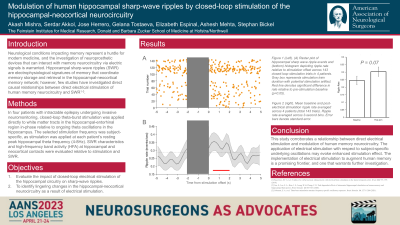Modulation of Human Memory Neurocircuitry by Closed-loop Stimulation of the Hippocampal-neocortical Network
Friday, April 21, 2023


Akash Mishra
Medical Student
Donald and Barbara Zucker School of Medicine at Hofstra/Northwell
ePoster Presenter(s)
Introduction: Neurological conditions impacting memory represent a hurdle for modern medicine, and the investigation of neuroprosthetic devices that can interact with memory neurocircuitry via electric signals is warranted. Hippocampal sharp-wave ripples (SWR) are electrophysiological signatures of memory that coordinate memory storage and retrieval in the hippocampal-neocortical memory network; however, few studies have investigated direct causal relationships between direct electrical stimulation of human memory neurocircuitry and SWR.
Methods: In four patients, closed-loop theta-frequency stimulation was applied directly to white matter tracts in the hippocampal-entorhinal region in-phase relative to ongoing theta oscillations in the hippocampus. The selected stimulation frequency was subject-specific, as stimulation was applied at each patient’s resting peak hippocampal theta frequency. SWR characteristics and high-frequency band activity (HFA) at hippocampal and neocortical contacts were evaluated relative to stimulation and SWR.
Results: Relative to baseline, theta-frequency stimulation evoked an increase in SWR rate that outlasted the end of stimulation train by 2 seconds (p < 0.01), and across patients, SWR rate increased by 50% (p=0.07). SWR in the post-stimulation window were found to evoke increased HFA in anterior temporal lobe (ATL) contacts relative to baseline SWR (p=0.03), indicative of increased SWR-evoked cortical activity.
Conclusion : This study corroborates a relationship between direct electrical stimulation and modulation of human memory neurocircuitry. The application of electrical stimulation with respect to subject-specific underlying oscillations may evoke enhanced stimulation effect. The implementation of electrical stimulation to augment human memory is a promising frontier, and one that warrants further investigation.
Methods: In four patients, closed-loop theta-frequency stimulation was applied directly to white matter tracts in the hippocampal-entorhinal region in-phase relative to ongoing theta oscillations in the hippocampus. The selected stimulation frequency was subject-specific, as stimulation was applied at each patient’s resting peak hippocampal theta frequency. SWR characteristics and high-frequency band activity (HFA) at hippocampal and neocortical contacts were evaluated relative to stimulation and SWR.
Results: Relative to baseline, theta-frequency stimulation evoked an increase in SWR rate that outlasted the end of stimulation train by 2 seconds (p < 0.01), and across patients, SWR rate increased by 50% (p=0.07). SWR in the post-stimulation window were found to evoke increased HFA in anterior temporal lobe (ATL) contacts relative to baseline SWR (p=0.03), indicative of increased SWR-evoked cortical activity.
Conclusion : This study corroborates a relationship between direct electrical stimulation and modulation of human memory neurocircuitry. The application of electrical stimulation with respect to subject-specific underlying oscillations may evoke enhanced stimulation effect. The implementation of electrical stimulation to augment human memory is a promising frontier, and one that warrants further investigation.
